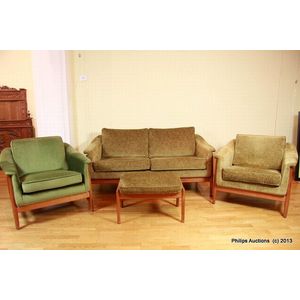Cromwellian Oak Dining Chairs with Suede Upholstery
You must be a subscriber, and be logged in to view price and dealer details.
Subscribe Now to view actual auction price for this item
When you subscribe, you have the option of setting the currency in which to display prices to $Au, $US, $NZ or Stg.
- Turned Legs - are legs which have been turned on a lathe. In use from the 16th century, turned legs on tables, chairs and cabinets became more frequent until, by the 1830s, the Georgian square or tapered leg was rarely found except in country pieces.
- Oak - Native to Europe and England, oak has been used for joinery, furniture and building since the beginning of the medieval civilisation. It is a pale yellow in colour when freshly cut and darkens with age to a mid brown colour.
Oak as a furniture timber was superceded by walnut in the 17th century, and in the 18th century by mahogany,
Semi-fossilised bog oak is black in colour, and is found in peat bogs where the trees have fallen and been preserved from decay by the bog. It is used for jewellery and small carved trinkets.
Pollard oak is taken from an oak that has been regularly pollarded, that is the upper branches have been removed at the top of the trunk, result that new branches would appear, and over time the top would become ball-like. . When harvested and sawn, the timber displays a continuous surface of knotty circles. The timber was scarce and expensive and was used in more expensive pieces of furniture in the Regency and Victorian periods. - Cromwellian - A term used to describe a type of 16th and 17th century leather covered chair, either upright or with arms, with an austere rectangular partly upholstered back, the upholstery decorated with brass headed nails.
- Turning - Any part of a piece of furniture that has been turned and shaped with chisels on a lathe. Turned sections include legs, columns, feet, finials, pedestals, stretchers, spindles etc. There have been many varieties and fashions over the centuries: baluster, melon, barley-sugar, bobbin, cotton-reel, rope-twist, and so on. Split turning implies a turned section that has been cut in half lengthwise and applied to a cabinet front as a false decorative support.
- Bobbin Turning - This turning resembles a series of compressed spheres, not unlike a row of beads or bobbins. Commonly associated with Jacobean-style furniture, bobbin turning is also found on a wide variety of small cedar and pine tables and washstands made in Australia during the late 19th century and up to the first world war.
This item has been included into following indexes:
-
chairs, sets of 6, timber
- all styles and timbers 737
- oak 92
- furniture, period or style - Cromwellian 7
Visually similar items

A four piece teak lounge suite, circa 1950-60s, in the Fler style, but unmarked, comprising a two seater lounge, two conforming chairs and an adjustable footstool, with partly exposed frames with side stretchers and tapering rounded legs, the arms and back

A set of eight Victorian English oak chairs, recently upholstered

Four circa 1900s dining chairs with suede upholstery (4)

Pair of Edwardian side chairs with carved and turned spindle backs, turned front legs
